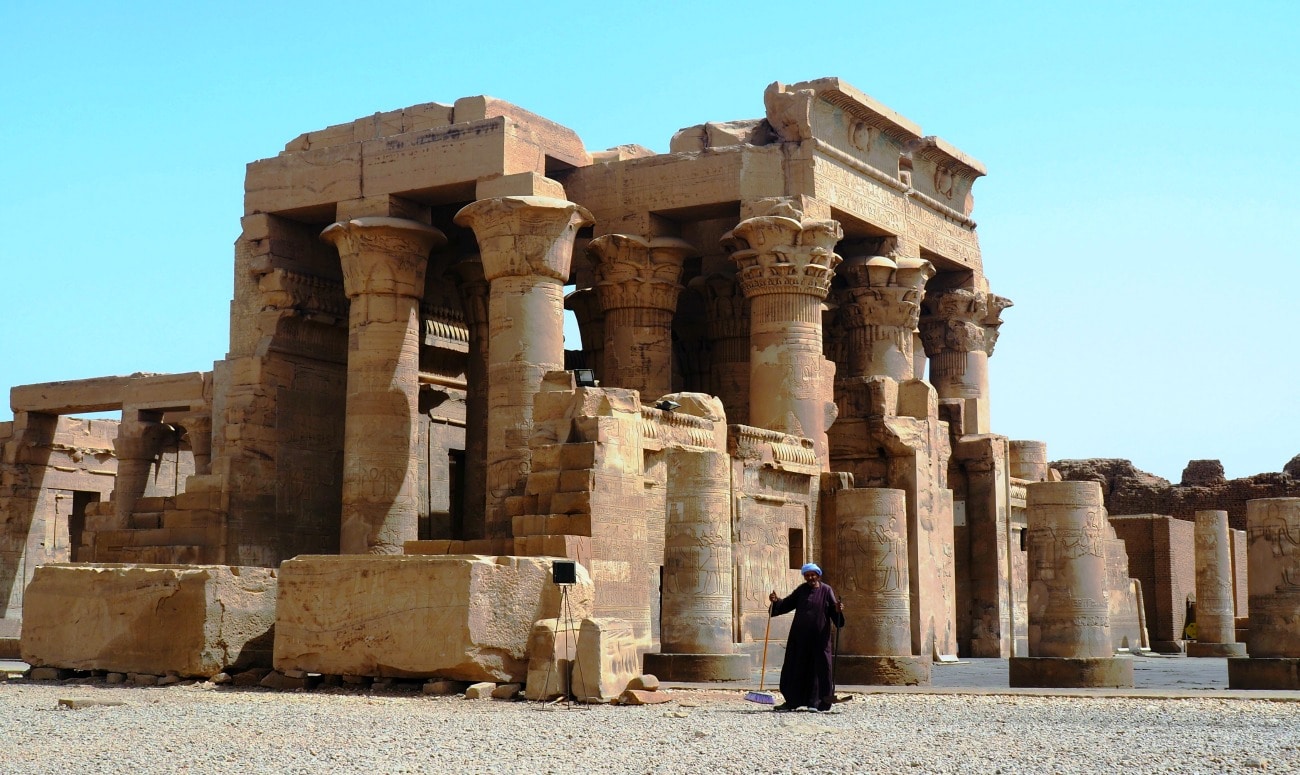Egypt should be on everyone’s bucket list. It was, after all, a tourist destination for the ancient Greeks and Romans who visited this wondrous land to marvel at the Pyramids and the Colossi of Thebes. Along the Nile are more must-see, astonishing sights. For an enjoyable and relaxing way to visit, consider sailing. All manner of tourist ships cruise the river with stops for shore visits. We chose a Dahabiya, a type of passenger sailboat popular on the Nile. Our comfortable craft had eight cabins, each with its own bath. “There’s no place I’d rather be than on the water,” said my friend Lynne once who had spent much of her youth on a sailboat. Now I can relate. Cruising the Nile was a delight– serene and soothing as well as entertaining.
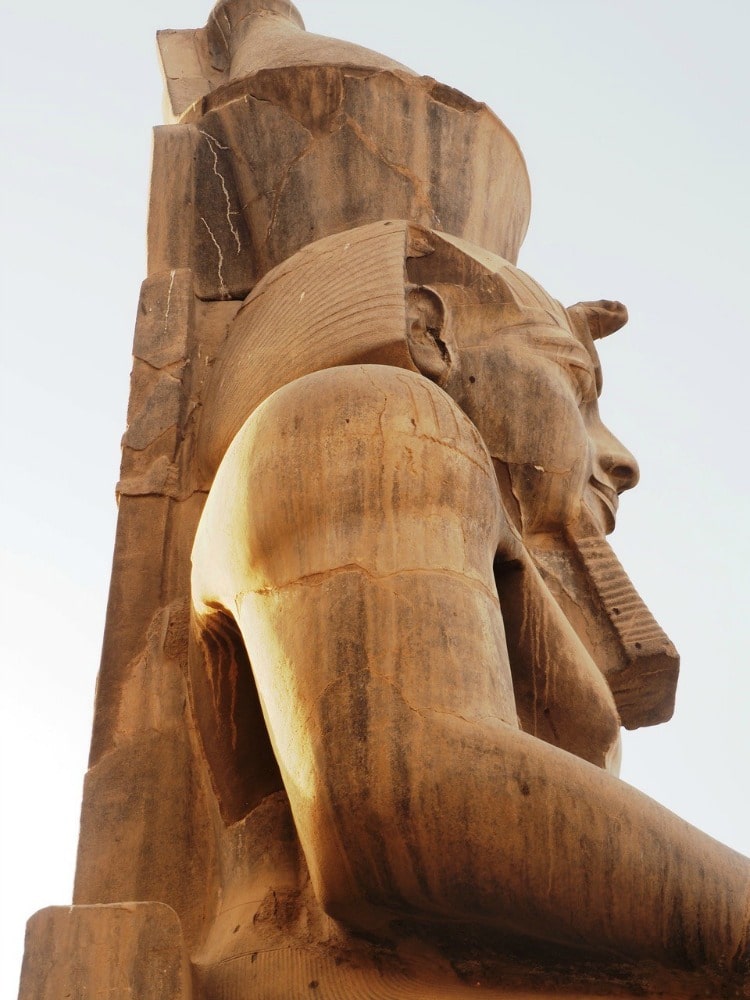
Introducing the Nile
The Nile is calm. The only sounds were the purr of the tugboat motor and an occasional call to prayer from an onshore mosque. Meals, delicious and copious, were on the open upper deck, but under an awning (the Egyptian sun is powerful). Our 12 shipmates came from six different countries. While the Egyptian staff were friendly and helpful, they were not exactly eager to hoist the ship’s two sails. We repeatedly asked when we’d be “sailing”, literally. Finally, they gave in to pressure and raised one of them (quite a procedure) which stayed up only long enough for a few souvenir photos. It was the towboat that kept us going.
The Nile, the world’s longest river, originates in the highland lakes of Uganda and Ethiopia and flows into the Mediterranean. For centuries civilizations have settled along its fertile valley. The rest of Egypt is mostly desert as we could see on our long (four hours) and somewhat boring ride from Hurghada on the Red Sea where our flight landed. We cruised from Luxor upriver to Aswan, then back to Luxor, disembarking most days to visit the extraordinary sights, ancient temples and tombs.
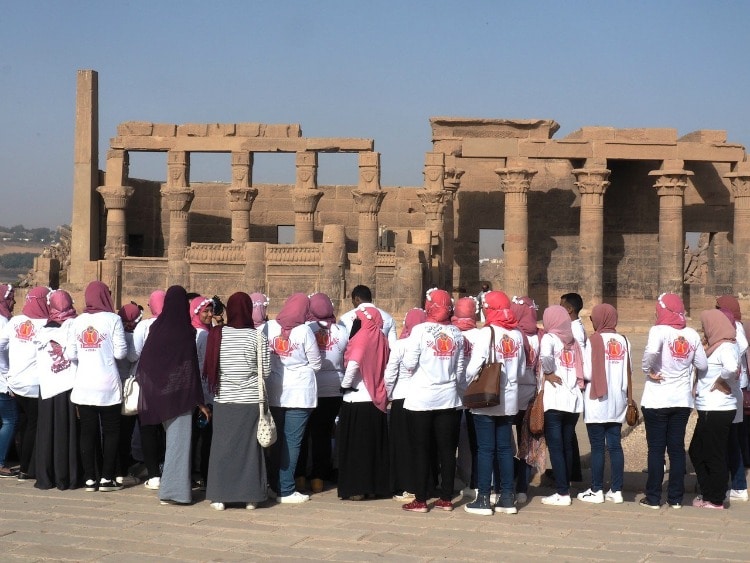
The Valley of the Kings
The Valley of the Kings outside Luxor with its richly decorated royal tombs is astonishing. For a period of some 500 years (16th to 11th century BC) Egyptians buried the mummies of pharaohs in secret, elaborate tombs here believing they would be saved for eternity. Sixty -three tombs have been discovered; eight are open for viewing, but not all at the same time. The most famous is Tutankhamen’s, discovered by Howard Carter in 1922. Descending shafts into this underworld of murals depicting gods, goddesses, kings, queens, snakes, beasts and battles is an adventure. Guides give lessons on Egyptian mythology, explaining who’s who, but keeping track is a challenge. Hats off to Egyptologists.
Even though we visited the Valley of the Kings early in the day, it was hot and quite crowded. Tourism in Egypt it seems is threatening the treasures. Visitors to the tombs are said to leave behind 2.8 grams of sweat each which corrodes the murals. A long-term goal is to create life-size replicas of the royal tombs at a nearby site so tourists would no longer see the real thing.
Exploring Esna
Fortunately for us we continued cruising on up the Nile to see more, returning to Luxor at the end of the adventure for visits to the famed Karnak temple complex and the city bazaar. To avoid the heat and the crowds, we often disembarked very early or late in the day. We arrived in Esna as the town was waking up, shopkeepers putting out their wares and children setting off to school. The aroma of freshly baked bread drifted through the alleys.
We were the only visitors to Esna’s Temple of Khnum which made it especially enjoyable and intriguing. The temple was buried under Nile mud for centuries and houses were built on top. In 1860 only the Hypostyle Hall was excavated to minimize further damage to the town. It sits nine meters below ground level, down crumbling steps. Our guide pointed out architectural details and told us about the ram-headed god Khnum, the temple’s namesake.
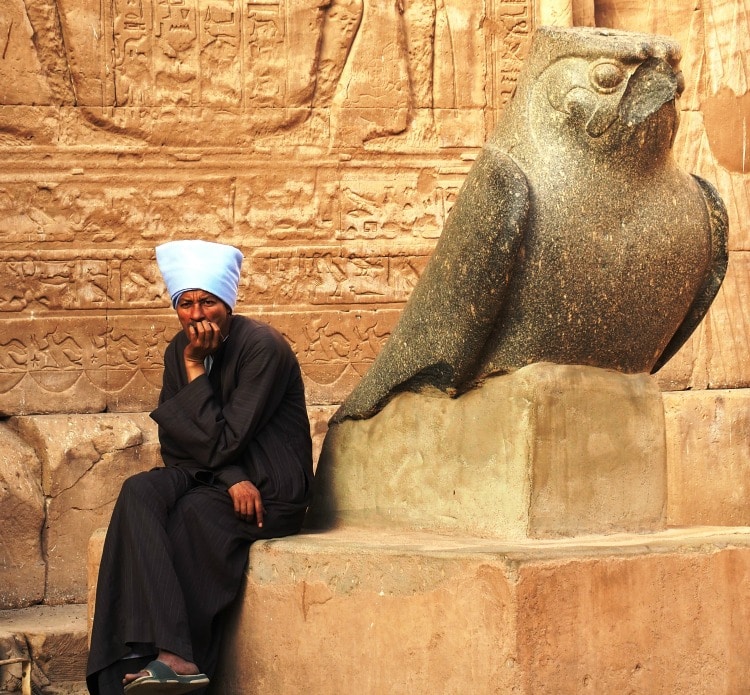
Edfu’s Temple
Edfu’s temple is dedicated to Horus, the falcon god. The mammoth edifice ranks as one of the Nile’s finest sites and it’s popular with both tourists and aggressive vendors. No matter where you go in Egypt, you’ll encounter hucksters plying souvenirs and more. We had been warned that it was best to ignore them because If you show even the slightest interest in their wares, they will pester you annoyingly until you give in and buy something. One day a group of children followed me, and I disobeyed that advice. They should be in school, not selling souvenirs, we were told. But this time it was late in the day and the kids were irresistible. I weakened and bought a few cheap bracelets. Children frequently followed us on our visits, practicing their English: “Where you from?” “What’s your name?”
By the time we reached Edfu’s temple (a carriage ride from the boat) most tourists had departed. The haunting call to prayer echoed through colonnaded passageways with the sun’s fading light adding to the mysterious ambiance. This was the Egypt of legends.
Temples and Tombs
At Kom Ombo we visited a temple dedicated to two gods, Haroeris (the “good doctor”) and Sobek (the crocodile god). Egyptians worshipped and feared crocodiles. The site features a crocodile museum with mummified crocodiles. On the doctoring side of the temple, our guide pointed out a wall relief depicting pharmacy instruments as well as hieroglyphics detailing recipes for medications.
From Aswan, where our boat turned around for the return to Luxor, an optional tour to Abu Simbel was offered. I remember being impressed by this monumental sight with its gigantic statues on a previous visit years ago. I wanted my husband to see it. By car the trip is four hours through the desert. To avoid the heat, we had a 4 a.m. wake up call. Even though we arrived at 9 a.m. the sun was already blistering. Throngs of Chinese tourists with cell phone cameras clogged the narrow passageways inside the tombs.
What is remarkable about Abu Simbel, and several other huge temple complexes is that they were all moved to be saved from drowning under the waters of Lake Nasser, the world’s largest reservoir created when the High Dam (the second dam) was constructed on the Nile. Between 1964 and 1966 Abu Simbel was hand sawed into 1041 blocks weighing up to 30 tons each and reassembled 210 meters behind its original site. We visited the dam and the impressive Soviet-Egyptian monument honoring the cooperation between the two nations in its construction.
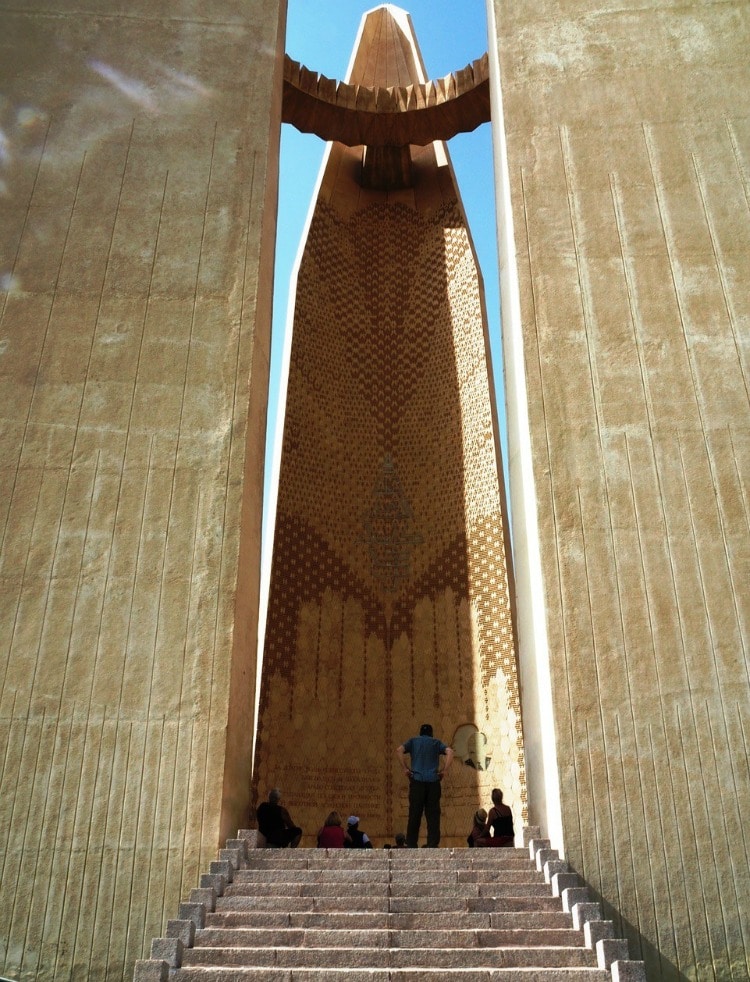
Language Lessons and Photo Opps
Another optional tour, to a Nubian village, was disappointing. Nubians, the earliest settlers on the Nile with their own culture and language, still live in traditional villages in southern Egypt. Unfortunately, the one we visited was primarily a collection of shops selling the usual souvenirs. However, it did include an entertaining visit to a school where a jovial “teacher” stood at a blackboard and instructed us in pronouncing our names in Nubian. Lots of laughs. This time we were surrounded by Taiwanese. They loved it.
Karnak, our final site visit, is gigantic, with three different enclosures on three square kilometers. After following the guide to the most notable ruins, we had time to explore – and photograph – at leisure. Here, as at other sites, enterprising Egyptians wearing their long gallabiyahs, offer to show you the best spots for photos, then pose for the perfect shot. Of course, they expect baksheesh (tips). If they don’t think it’s enough, they will let you know.

Bargaining and Balloons
Shopping is part of the travel experience. As with most group tours, our guide led us to his shops, warning that we could be ripped off shopping elsewhere. Of course, the guides get their cut at these places. I like to shop and explore on my own and pleaded to visit the bazaar. The guide was very reluctant, but finally, I escaped long enough to find a pair of silver earrings. I relished wandering through the colorful, congested souks, taking photos and bargaining with vendors without the group and leader.
We had hoped to end our visit to the Nile and its sights with a balloon ride. British passengers on our boat had been enthralled with the river views, the Valley of the Kings, the desert and more.
Another 4 a.m. wake up call. We were driven to a field where huge colorful, deflated balloons blanketed the ground, surrounded by groups of eager passengers. It was cold at that early hour without a single refreshment stand offering coffee. We waited, and waited, and waited, about three hours, for the signal that visibility was OK, and we could soar into the sky. Sadly, visibility never improved, so no balloon ride.
But the boat was bliss.
Our cruise as described here was booked with Memphis Tours Cairo, www.memphistours.com. Prices for an 8-day, 7-night cruise on a Dahabiya vary with the season, starting at $1945 per person. All cabins have private baths and meals are included. Cruises depart year-round from Luxor on Saturdays.

